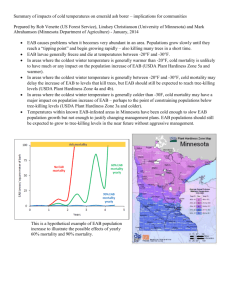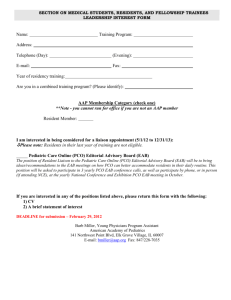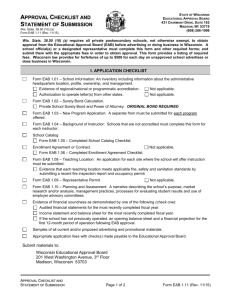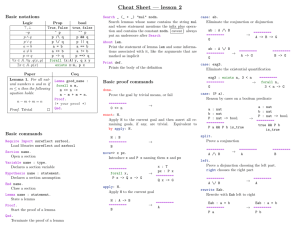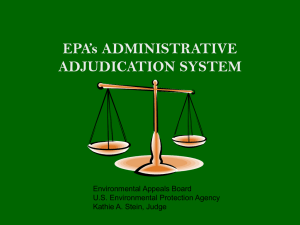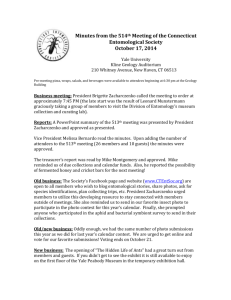EAB-U: Emerald Ash Borer University
advertisement
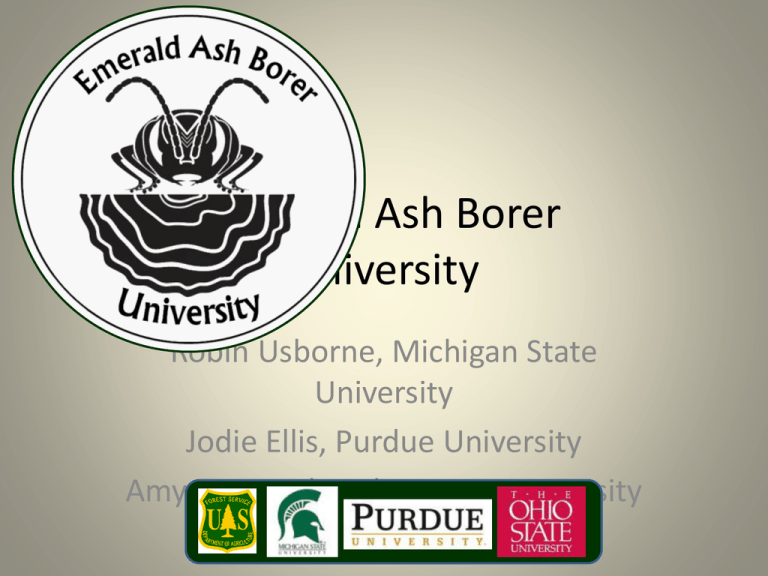
Emerald Ash Borer University Robin Usborne, Michigan State University Jodie Ellis, Purdue University Amy Stone, The Ohio State University Robin Usborne, EAB Communications Manager, Michigan State University • Educators from “core” EAB states • Members of APHIS EAB Regional Amy Stone, OSU Extension educator (Lucas County) and Communications Group coordinator of the Ohio State University EAB • Directly connected to scientists Outreach Team, The Ohio State University and regulators working with EAB • Jodie 18Ellis, years of experience with EABof Exotic Insects Education Coordinator, Department Entomology, Purdue University Elements Necessary For A Successful Invasion The Right Species + The Right Host + The Right Ecosystem The Human Factor Some things we believe…. • Management of invasive species is not possible without the cooperation of an informed and engaged public. • “Ditto” for affected industries. • The most important factor in education about invasive species is… Clear, consistent, coordinated messages Educating People About Emerald Ash Borer “Out of the Ashes” Dayton, OH EAB Regional workshop on EAB science and management Sept. 24-25, 2008 in Dayton The Challenges of Multi-State Educational Programs About EAB • Multiple institutions with different sources of funding • Costs of meetings and conferences for organizers • Costs of meetings and conferences for audience • Ever-shifting messages, continuous updates • Distance between states We share the same goals, sensibilities, and sources of knowledge. Even the same EAB suit…… Web Conferencing Web conferencing is used to conduct live meetings, training, or presentations via the Internet. In a web conference, each participant sits at his or her own computer and is connected to other participants via the internet. Why Web Conferencing? • As finds of EAB increase, and as more states join the ranks of the EAB-infested, delivery of educational programs and accurate, coordinated information becomes increasingly important. • Travel to conferences, educational workshops and meetings may be curtailed due to budget cuts, lack of time, or distance involved to attend a meeting. Web conferencing? • Web conferencing pluses – Little or no travel involved – Anyone with a computer and Internet access with a decent bandwidth can use it. – Presentations can be recorded and archived for future use, either as a review or as information for users in newly-infested areas. “EAB University: Using Web-based Seminars Cooperatively to Provide Information about EAB to Targeted Audiences” How Web Conferencing Works • Requires a host/administrator who handles all logistics for the conferencing (like a “live” conference coordinator) – Schedules conference and notifies participants of meeting time and URL. – Acts as moderator during presentation, fielding questions and chat so that presenter concentrates on presentation and can answer questions at appropriate times. • Presenter – Uploads presentations or materials to the conferencing site. • Presenter can be part of a conference call, or could use a microphoned headset. • Bandwidth issues make it easiest to use conference call system right now. Presentations can be recorded • PowerPoint presentations can be recorded and archived. • We can offer printed and/or downloadable materials. – This could be part of an information packet developed for the conference. “EAB University” • A set of modules tailored for the specific audiences – Municipal leaders/foresters, regulatory officials, green industry – Extension and other educators, woodland owners, golf course superintendents, firewood dealers, other industry specialists and leaders Modules focus on most needed information about EAB • Basics like biology, life cycle, origin • Technical information like insecticides, ash utilization, scouting for EAB, creating girdled trees and survey methods • Regulatory issues • Planning for EAB, and what to do once it arrives (from those that have dealt with it) Modules can focus on what participant needs • Participants can “mix and match” modules to get information that they need the most. • Could include biology/life cycle as one “free” module. Upcoming Topics Topic Date EAB 101: The History of EAB and Basic Information November 12, 2009 The Use Of Pesticides to Manage EAB December 3, 2009 EAB Research Updates (Parts 1 and 2): The Latest Information From Researchers Part 1, January 7, 2010 Utilization of Ash in the Wake of EAB Part 2, January 14, 2010 February 4, 2010 Management of Woodlots to Prepare For EAB February 11, 2010 Regulatory Issues About EAB March 4, 2010 Helping Communities Prepare for and Live With EAB March 18, 2010 What Happens After Ash Is Gone? April 1, 2010 2010 EAB Awareness Week : Ways to Get The Word Out About EAB in Your Area April 8, 2010 www.emeraldashborer.info
